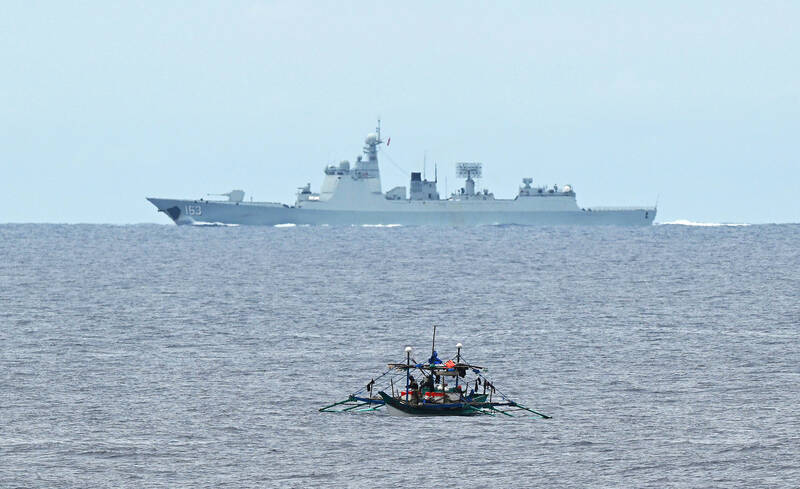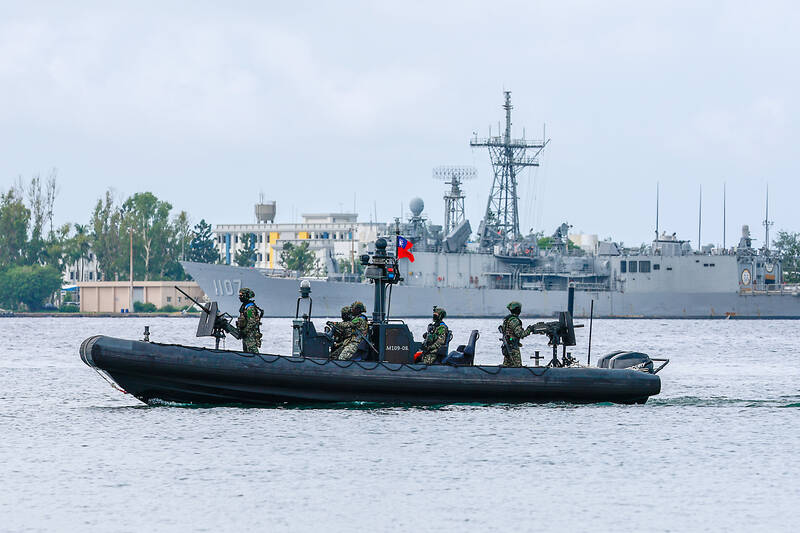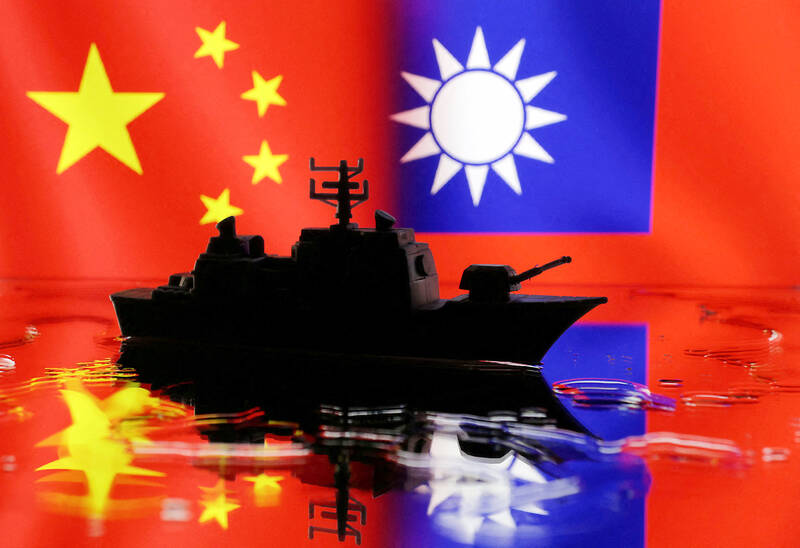Late last month Philippines Foreign Affairs Secretary Theresa Lazaro told the Philippine Senate that the nation has sufficient funds to evacuate the nearly 170,000 Filipino residents in Taiwan, 84 percent of whom are migrant workers, in the event of war. Agencies have been exploring evacuation scenarios since early this year, she said. She also observed that since the Philippines has only limited ships, the government is consulting security agencies for alternatives.
Filipinos are a distant third in overall migrant worker population. Indonesia has over 248,000 workers, followed by roughly 240,000 Vietnamese. It should be noted that there are another 170,000 Vietnamese in Taiwan married to locals. Hence, roughly 1 in every 33 Taiwanese residents is southeast Asian.

Photo: AFP
HOT WAR
Foreign Minister Lazaro’s testimony was a brave speech, intended to reassure, but it is a fantasy. Everyone in Taiwan will be trapped when the war begins. No one is getting out.
It is difficult to imagine that in the chaos of a hot war, with air and sea combat taking place across the South China Sea and in the Bashi Channel between Taiwan and Luzon, how 170,000 Filipinos are going to be evacuated. It is impossible to imagine how another half million or more Vietnamese and Indonesians are going to be evacuated — all at the same time as the Filipinos, along with the tens of thousands of Americans, Canadians, Japanese and other nationalities. Of course, hundreds of thousands of Taiwanese will be attempting to flee as well. Further, the Japanese will also be removing the roughly 120,000 civilians who live on the Japanese-owned islands east of Taiwan in the event of war with China, as they announced back in March of this year. Air and sealift to Japan will be at a premium.

Photo: EPA
Many readers have probably evolved some hazy vision of escape when the fighting begins. A flight out? Most of these fantasies are based on having weeks or months of warning. Not anymore. As incursions by the forces of the People’s Republic of China (PRC) into local air and sea space have become normalized, the warning period has shrunk. At a panel discussion organized by Taiwan Thinktank last week, military expert Kao Chih-jung (高志榮) said that the PRC will probably take up to two weeks to prepare its forces for an invasion.
Two weeks, perhaps even less. Imagine the chaos at Taiwan’s airports, which are inevitable targets of bombardment. A pro-Ukraine hacker group in July took down Aeroflot’s computer systems, crippling flights across Russia. Recall that in 2022 during then US House of Representatives speaker Nancy Pelosi’s visit to Taiwan, hackers from Russia and the PRC took control of screens across Taiwan, from 7-11s to the government, paralyzing them. Power outages will be easy for the PRC to arrange. In a real war, organized aviation in Taiwan will cease to exist hours, perhaps days, before the first drones and missiles hit the aircraft and equipment at Taiwan’s airports.
Well ok, the reader’s hazy fantasy might run, there are still fishing boats. Nope. Taiwan’s distant water fleet is almost entirely crewed by migrant workers, and their captains, usually far from Taiwan, will not return to enter a combat zone. The small fishing craft that ply the waters off Taiwan have a lower proportion of migrant workers, but they too will largely cease functioning as their crews melt away. They aren’t paid enough to run the gauntlet of drones and PRC ships. Moreover, fishing boats use fuels that will be restricted in the event of war, while sealift capable of transporting large quantities of people (like Taiwan’s inter-island ferries) is going to be reserved for military use or destroyed in the opening attacks. Sadly, Taiwan’s outlying islands will likely be cut off.

Photo: Reuters
BLOCKADE
It probably won’t come to war, right? It will be a blockade. Perfectly safe. Earlier this year the Center for Strategic and International Studies (CSIS) ran 26 wargames to explore various blockade scenarios.
“In most free-play games, despite a reluctance to escalate, teams responded to perceived escalations with minor escalations of their own and in two games spiraled to a general war,” the study’s summary said.
Casualties in fixed-escalation games were high. The focus in a blockade won’t be getting people out, but getting cargo in. Many ships will be damaged or sunk. The likelihood that the blockade will involve missile and drone attacks on Taiwan is high, especially since PRC doctrine calls for attacks on Taiwan in the event of a blockade. What happens to commercial airline flights at that point? Many flights will be halted even before attacks occur because airlines won’t want to risk Beijing’s ire.
The CSIS wargames showed that “rapidly acquiring ships to run the blockade was critical because regular shipping companies would not take the risk of getting involved.” It is true that the fleet of Taiwanese-owned vessels is large, but the crews are not Taiwanese. Indeed, in many cases officers and crews of Taiwanese-owned ships may be Chinese (hello, sabotage). The problem thus isn’t going to be finding hulls, but crewing them. There is simply no great reserve of Taiwanese mariners.
Moreover, unlike migrant workers who make minimum wage and lack the savings to bribe their way out of Taiwan, the foreign crews of Taiwanese cargo vessels will often have the wherewithal to fly home from wherever in the world they make port, even at the risk of contractual punishment.
The Philippines is the world’s leading source of migrant mariners. For example, over a third of the mariners in the US fleet are Filipinos (roughly 9 percent are Chinese). In time of war how many would stay on ships being shot at, when they can easily find work in the ships of neutral nations or stay at home for a few months? Rotating home, after all, is totally normal for Filipino mariners. It is true that Filipinos also comprise roughly a third of Russian shadow fleet crews, but nobody is sinking those ships at the moment.
In an invasion, Taiwan will be a nation of ships without crews, while the Philippines will be a nation of crews without ships. Seems like a match made in heaven, but it must be fashioned into a joint policy. Being able to remove its people from Taiwan should be a powerful incentive for Manila to strike a deal on providing volunteer crews for blockade running. Taiwan also needs to begin expanding and hardening its ports in the south and on the east coast with an eye to handling mass quantities of incoming cargo and outgoing humans. In a conflict with the PRC, even tiny ports like Houbihu (後壁湖) and Houwan (後灣) in Kenting will assume critical importance.
Notes from Central Taiwan is a column written by long-term resident Michael Turton, who provides incisive commentary informed by three decades of living in and writing about his adoptive country. The views expressed here are his own.

US President Donald Trump may have hoped for an impromptu talk with his old friend Kim Jong-un during a recent trip to Asia, but analysts say the increasingly emboldened North Korean despot had few good reasons to join the photo-op. Trump sent repeated overtures to Kim during his barnstorming tour of Asia, saying he was “100 percent” open to a meeting and even bucking decades of US policy by conceding that North Korea was “sort of a nuclear power.” But Pyongyang kept mum on the invitation, instead firing off missiles and sending its foreign minister to Russia and Belarus, with whom it

When Taiwan was battered by storms this summer, the only crumb of comfort I could take was knowing that some advice I’d drafted several weeks earlier had been correct. Regarding the Southern Cross-Island Highway (南橫公路), a spectacular high-elevation route connecting Taiwan’s southwest with the country’s southeast, I’d written: “The precarious existence of this road cannot be overstated; those hoping to drive or ride all the way across should have a backup plan.” As this article was going to press, the middle section of the highway, between Meishankou (梅山口) in Kaohsiung and Siangyang (向陽) in Taitung County, was still closed to outsiders

President William Lai (賴清德) has championed Taiwan as an “AI Island” — an artificial intelligence (AI) hub powering the global tech economy. But without major shifts in talent, funding and strategic direction, this vision risks becoming a static fortress: indispensable, yet immobile and vulnerable. It’s time to reframe Taiwan’s ambition. Time to move from a resource-rich AI island to an AI Armada. Why change metaphors? Because choosing the right metaphor shapes both understanding and strategy. The “AI Island” frames our national ambition as a static fortress that, while valuable, is still vulnerable and reactive. Shifting our metaphor to an “AI Armada”

The Chinese Communist Party (CCP) has a dystopian, radical and dangerous conception of itself. Few are aware of this very fundamental difference between how they view power and how the rest of the world does. Even those of us who have lived in China sometimes fall back into the trap of viewing it through the lens of the power relationships common throughout the rest of the world, instead of understanding the CCP as it conceives of itself. Broadly speaking, the concepts of the people, race, culture, civilization, nation, government and religion are separate, though often overlapping and intertwined. A government